Welcome back to the Odyssey. As always, you can click here to read all parts of the journey covered so far. Last time, we took a look at the 2001 SEC season. Today, we’re going to take a look at the 2001 Pac-10 season. Coming off one of its successful seasons, with one major star returning, the conference seemed to be an open and shut case.
Act I: Big Game Hunting
The 2000 Pac-10 season may some of the most successful seasons for multiple programs. Oregon State finished 11-1, one FG away from a potential undefeated season and National Championship appearance. Washington won the conference for the first time since their 1992, and first top five finish since their 1991 National Championship season. Oregon was ranked in the top ten in the final AP Poll for the first time since 1948. Despite the conference’s best demographic struggling (in USC and UCLA), the conference was able to produce three top ten teams.
Hype was high for the following season. Most had pegged those three teams to be in the hunt for the conference and the national title picture. Most had agreed that Oregon, who was on a trajectory of more national relevance under QB Joey Harrington, was going to be the conference champion and potential player in the National Championship scene. However, Sports Illustrated planted their flag on Oregon State as their #1 team in the preseason.
I’m not joking. Here’s the link. Go read it and come back.
So the hype was pretty high for these teams, and the conference. UCLA was also expected to bounce back from their 2000 season. They were ranked as high as #6 before losing three out of four and their last three games, including their bowl. The conference slate was one to watch in 2001.
Act II: When the Dam Breaks
While Oregon State did not start the season as the AP #1 team, they did get a top 10 ranking. This respect was despite the Beavers losing their top two weapons in Chad Johnson and TJ Houshmandzadeh, both of whom went to the NFL. They did return their senior WB leader Jonathan Smith and RB Ken Simonton. Simonton was the cover athlete of Sports Illustrated when they were crowned the #1 team, with others believing he had a chance to win the Heisman. This says nothing of the Oregon State defense, who returns 5 starters and looked to continue their top defense from a season prior.
The Beavers were forced to quickly defend that ranking, with a trip to Fresno at the beginning of the season. We briefly touched upon the Fresno State season kicking off with their upset win at Colorado. It looked like David Carr and the Bulldogs now had an opportunity to put themselves on the map. The story of the game early was all Fresno State. The Bulldogs defense forced two three and outs in the first quarter, shutting out the Beavers. Meanwhile, Carr had the Bulldogs offense running smoothly, getting ten points on the Beaver defense.
Oregon State would kick a FG early in the second quarter to get on the board, but they would need to play from behind the rest of the first half. Fresno State played fearless on the ensuing drive, converting multiple third down conversions on the drive. They also converted a 4th and goal, as Carr hit Jeremy Johnson to increase the Fresno State lead to 17-3. After the teams traded punts, Oregon State finally broke through. Smith and Simonton found their grooves as Oregon State moved 72 yards in just 2:16. The drive was punctuated with a Simonton 17 yard TD rush. The score would stay at 17-10 going into the half.
The second half began with both defenses adjusting the explosive offenses; each team punting the ball away. The next Fresno State drive set the tone for the rest of the game. Carr hit passes of 17 (to Johnson), 16 (to Rodney Wright) and 28 yards (to Bernard Berriman), leading to a TD, and increasing the Bulldog lead. Oregon State punted on the ensuing possession and Carr unleased his best throw of the night. He hit Rodney Wright for 70 yards, with Wright outrunning the defense most of the field, to give Fresno State a 31-10 lead.
Oregon State’s offense woke up and adjusted to the setback. The spark came from the nice return by Patrick McCall; taking the kickoff 69 yards to get deep into Bulldog territory. Smith then found George Gillett for a six yard TD. Fresno State punted the ball after a stalled possession, and the Beavers continued to roll. On the first play, Smith hit Seth Trimmer in stride and he took it the distance, putting Oregon State down 31-24.
Carr once again found his rhythm as he marched the Bulldog offense down the field. The quick drive culminated in a deep pass down the right sideline to Wright for a TD. Oregon State tried to rebound, but the first mistake was made as a pass by Smith was bobbled and intercepted by Fresno State. The Bulldogs kicked a FG on the ensuing drive and never looked back. Fresno State added another field goal to put the final score at 44-24, upsetting the top 10 Beavers.
Oregon State would rebound the next week against New Mexico State, but Oregon State’s falter was the only one for the top tier Pac-10 teams in the early non-conference play. Washington knocked Michigan. UCLA went to Tuscaloosa and won. Oregon won a close game against Wisconsin. Plus, as we mentioned in the Big Ten post, UCLA would go on to beat Ohio State at home. The Bruins were 3-0 and close to a top ten ranking when they had to go on the road to Corvallis.
The opening possessions for both teams would be a harbinger of both the game, but also the season for Oregon State. Jonathan Smith threw an interception to Jason Stephens. Stephens, with the help of Ricky Manning Jr. after a brief fumble, got the ball inside the Oregon State 30. DeShaun Foster took it the rest of the way and it was off to the races. The UCLA defense stifled the Oregon State offense all day, forcing six punts in the first half alone. UCLA added a field goal before a TD pass from Cory Paus to Brian Poli-Dixon put the Bruins up 17-0 at halftime.
Foster, Paus, and Poli-Dixon were major players in the second half, combining for all of the UCLA points in the second half. Oregon State had no response, not scoring until late in the game to get on the board. Foster finished with 147 yards and 3 TDs on the day for UCLA, with Poli-Dixon catching 6 balls for 107 yards and 2 TDs. Oregon State punted the ball 10 times on the day and added three turnovers on top of that. The Beavers were now on implosion watch.
The next weekend Oregon State went to Pullman to take on Washington State, who was looking for a statement win in the conference. They had knocked off Boise State in Boise, but they only had played Cal and Arizona in conference. Wazzu came in with a chip on their shoulder and bared it immediately. Eric Coleman picked off a Jonathan Smith pass to take it to the house, giving the Cougars a 7-0 lead. When QB Jasson Gesser finally got his hands on the ball, he showed off the offense was legit as he drove his team down the field to make it 14-0 Washington State.
At the end of the first quarter, things really broke the wrong way for Oregon State. Terrell Roberts stepped in front of a Gesser pass, only for the ball to be ripped out by RB Dave Minnich, which was recovered by Washington State. Minnich had 195 yards on the ground and a TD catch on the day, but that may have been the play of the game. Gesser drove the Cougars down the field. Minnich once again shone, as on a halfback pass, he hit Nakoa McElrath for a TD, putting Wazzu up 24-0. The Cougars got to 31-0, before Oregon State attempted a comeback. However, it was too little too late and Washington State had the 34-27 victory. Oregon State was 1-3 on the season and seemingly out of the conference race.
Act III: A Rising Ty…
With Oregon State plummeting out of the Pac-10 race, the door was open for other teams to step in to take their place. UCLA had thrown their hat into the ring, and Washington State had an opportunity to improve their stock as well with a road test. Stanford was looking to bounce back from a disappointing 2000 season, where they were defending Pac-10 Champions. They did not make a bowl and their lowlight was a two touchdown loss at home to San Jose State. The non-conference went well for the Cardinal early, as they knocked off Boston College, Arizona State, and USC.
In the home game against Washington State, defense was at a premium. The score was tied at 21 briefly into the second quarter. Suddenly, Washington State blocked a punt returned for a TD, and the tides turned. The next three possessions ended in interceptions, with Washington State returning it for a TD to extend their lead. Stanford responded in the third quarter with 15 unanswered points to take a 39-35 lead. Washington State responded with a seven minute drive. It was punctuated by a Gesser TD pass to give Wazzu a lead they wouldn’t relinquish. Washington State kept their perfect season alive with a 45-39 win.
The bigger game that afternoon was a top ten matchup between Washington and UCLA. Washington had been living on the edge all season, winning games with fourth quarter comebacks . They had beaten USC the week prior on a last second field goal. They were in a need for a signature win to continue the success of the prior season.
However, the Huskies could not ask for a worse start. They fumbled away their opening possession. They then punted after three plays. The next possession, they went three and out and punted again. UCLA responded to both of those possessions with Foster TD runs. The next possession for Washington was the straw that broke the camel’s back. After a quick, stalled possession, Washington punted the ball back to UCLA. However, multiple Bruins broke through the line and blocked the punt and it was returned back for a TD. Washington pulled closer late in the second half, with a long TD pass.
The second half did not get better for the Huskies. It belonged to Foster. Foster busted out runs of 92 yards and 65 yards in TD drives for UCLA. He finished with 301 yards and four rushing TDs on the day, averaging almost 10 yards a carry on the afternoon. Washington could not get their offense off the ground in the second half, ending the game with a long TD drive to make the final score 35-13.
Following their loss to Washington State, Stanford faced Pac-10 behemoth Oregon. The Ducks had not been challenged since their close win against Wisconsin. They took care of USC and Utah in consecutive weeks, then went on a three game road trip. They were never challenged in wins over Utah State, Arizona, and Cal, leading to this showdown. The future division rivals hadn’t met since 1998, where Oregon won 63-28 in Eugene.
Much like the week before for Stanford, both offenses stole the show early. Stanford took the opening drive down for a TD through the arm of QB Randy Fasani. The drive was capped off with a Casey Moore rushing TD to put the Cardinal up 7-0. Harrington controlled the pace for the Ducks, completing three passes for 64 yards, including a TD to Keenan Howry to tie the game. Stanford responded, with the help of a lengthy kickoff return, with another rushing TD. Kerry Carter took it in for Stanford. The Oregon offense swiftly responded as Harrington threw another TD; this time to Justin Poole.
The Stanford offense ended up blinking first, as they got down to the Oregon 31 before stalling. On a 4th and 12, instead of trying to kick a 48 yard field goal, Ty Willingham and Stanford tried to get the conversion. Fasani’s pass fell incomplete and Oregon took over. Harrington would once again respond; hitting Howry for a 39 yard TD to take the lead. Stanford, undeterred, responded with yet another rushing TD by Carter, but not before losing their Quarterback. Fasani was hit on a scramble and left the game. The only score for the rest of the half was sparked after Howry took a punt down to the Stanford six. From there, Maurice Morris did the rest, giving Oregon a TD lead at halftime.
In the second half, the two defenses had made the correct adjustments to either offenses, as both teams traded punts to start the third quarter. Howry broke the game open for the Ducks; taking that fourth punt back to the house and increasing the Oregon lead.
Suddenly, the wheels started falling off for both teams. Brian Allen fumbled the ball on the ensuing possession for Stanford. Harrington’s first play on the next drive was intercepted. Lewis found his rhythm in the pocket, hitting Teyo Johnson for a TD to cut the Oregon lead. Special teams uplifted the Oregon offense once again as Onterio Smith returned the ensuing kickoff for a touchdown, keeping the two touchdown lead for the Ducks.
As the fourth quarter started, the urgency in Stanford took hold. The Cardinal blocked two punts on consecutive Oregon offensive possessions. On the first possession, they turned the ball over on downs after a stand by the Ducks defense. The second possession they broke through. Lewis hit Luke Powell on the first play to get the deficit down to a touchdown at 42-35. The Cardinal successfully attempted an onside kick to get the ball back. A healthy dose of Teyo Johnson in the passing game and the rushing game got Stanford within striking distance. Kerry Carter punched it in for a touchdown. However, Stanford missed the PAT so the score was now Oregon 42, Stanford 41.
Oregon now had the ball back, up one point, and 5 minutes to play. The question for the Ducks would be if their offense would get more conservative or would they let Harrington cook? The question was answered by the Stanford rush, which forced a Harrington interception on the third play of the drive. Stanford now had a chance to win in Eugene with 4 minutes to play.
Stanford stuck to their recipe of steady run game, with Lewis occasionally hitting either Johnson or Powell to advance the ball. This proved to be successful as the Cardinal got to the Oregon 3 on a 3rd and Goal opportunity with 1:15 left. Carter finished the drive with his fourth rushing TD of the day. Lewis would hit Johnson on the two point conversion to go up seven. Harrington tried to muster up some comeback magic, but after four straight incompletions, including an attempt at the end zone at the end of the game, Stanford had clinched their comeback and the upset.
With Oregon’s loss, Stanford and Oregon had motivations for the rest of the season; Stanford to win the Pac-10 and Oregon to win out and make a National Championship case. Oregon had to respond the week after with the team who beat Stanford two weeks prior; Washington State. Stanford faced another undefeated Pac-10 opponent in UCLA.
UCLA now stood alone at the top of the Pac-10 Standings after the Cardinal upset the Ducks. They still had their struggles offensively, as Cory Paus struggled to complete more than 50% of his passes. Luckily for the UCLA offense, the defense decided to score the first points of this game. After a lateral screen pass to Stanford’s Brian Allen was dropped, Ryan Nece picked up the ball. Amongst the confusion, Nece scampered into the end zone to put the Bruins up 7-0.
Stanford’s offense did have another turnover in the first quarter, but seemed to bounce back from the turnovers nicely. Chris Lewis, still in after the Randy Fasani injury, hit Luke Powell on his first TD pass of the half. Then, he hit Teyo Johnson on a fade; Johnson making a one handed effort to get his team on the board.
Now down two scores, UCLA needed one of two things to happen; either Paus needed to throw the ball efficiently to get his team back into the game, or DeShaun Foster needed to make a play to open up the field. Unfortunately for Foster (and his Heisman campaign), the Stanford defense bottled him up all afternoon. He gained 77 yards a TD on the afternoon, well below his average. He also fumbled the ball in his own territory, which led to a Stanford rushing TD of their own. Brian Allen took one play to turn the game into a rout, making it 21-7 Cardinal. On the ensuing drive, Paus tried to extend the field to close the gap, but was intercepted. Stanford responded with a connection between Lewis to Kerry Carter, making the score 28-7, which was the score at the half.
At the beginning of the second half, Paus was benched for backup Scott McElwan. The result for the Bruins offense was still the same; an interception. Stanford responded with a FG to extend their lead. UCLA responded with a drive capped by the aforementioned Foster TD, their first points since the first two minutes of the game. As the third quarter came to a close, McElwan hit TE Mike Seidman for a TD to cut the lead to 31-21. After both offenses committed turnovers; two for Stanford, one for UCLA, the Bruins had life in the game for the first time since the first quarter. McElwan hit Bryan Fletcher to cut the Stanford lead to 3.
After a Stanford interception, UCLA had the ball, less than four minutes left to play, and a chance for a lead and a potential road win. However, the Stanford defense stepped up again and forced a turnover on downs. Three plays later, Kerry Carter put the game on ice for Stanford. Stanford would win 38-28, now holding head to head victories over two of the best teams in the conference. Stanford was now in the driver’s seat for the conference.
Act IV: Flying North for The Winter
Oregon had it’s chance against Washington State later that day. As the rain poured down in Pullman, Harrington continued his relative struggles. His lack of output resulted in three consecutive punts for Oregon. Washington State took the lead on a field goal on the ensuing possession. Then, Onterrio Smith took over. Smith rushed for a TD on the following drive, carrying the ball for 47 yards on the drive. The halftime score stayed at 7-3 in the rain.
Smith continued to carry the ball for the Ducks at the beginning of the second half, carrying the ball for 72 yards on a TD drive. Oregon added a FG to extend their lead to 17-3. The Cougars responded to the FG with a TD drive of their own, finishing off a drive with a Mittich run to make it 17-10. Smith would make a final mark on the game, with a 73 yard TD run to break the single game school record for rushing yards, ending with 285 on the day.
Gesser responded for Washington State, trying to pass his way to overtime, but time had run short on the Cougars. After a short TD drive, Washington State had a chance to tie the game with a fourth and goal, but the fade to Mike Bush fell incomplete and Oregon survived. The Ducks had their Pac-10 and National Championship hopes alive.
With the losses by UCLA, Oregon, and Washington State, Washington was able to overcome its loss to UCLA and try and get back on track. They had a prime opportunity to stake their claim on the Pac-10 with a win over Stanford. They had their starting QB Cody Pickett returning to action, and the offense boomed because of it. Washington receivers averaged 22 yards a catch in their game over Stanford, which in turn opened up the running game. Willie Hurst rushed for 108 yards and scored 3 TDs for the Huskies.
Stanford, who in the second quarter was down 28-13 after Hurst’s first rushing TD, responded in kind with their running game. Brian Allen took the ball on the first play 80 yards to the house to put Stanford back in a one score game. The third quarter is where things started to go wrong for the Cardinal. The defense forced fumbles on consecutive possessions inside Huskie territory. They came away with zero points. They missed the first field goal attempt and had the second one botched, keeping their deficit at 8 after three quarters.
However, with ten minutes left, Brian Allen rushed into the end zone for his second time to push Stanford closer to the tie. After Chris Lewis hit Teyo Johnson, the game was tied in Seattle. Washington responded with a march down the field. The Huskies took 14 plays to go 77 yards, capped off with a Hurst TD run. Washington would add another Hurst TD run after forcing a turnover on downs. Stanford’s winning streak was over, and it opened the door for Washington, Washington State, UCLA, and Oregon to win the conference.

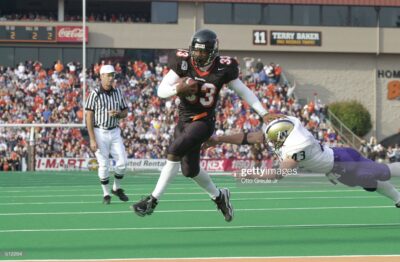
The next weekend, there were two major matchups that could shape the stretch run of the Pac-10 race, happening simultaneously. The first was the hyped matchup of Oregon vs UCLA. Unfortunately for the Bruins, they were in the middle of skid after their first loss of the season. They had lost the week previously to Washington State, committing seven turnovers in the process. Paus’ flaws had shown in that game, accounting for 3 of the 7 turnovers. Their path to winning the conference was now win out and hope for chaos.
UCLA got a dose of chaos on the opening drive, as Oregon missed their FG after driving down to the UCLA 24. UCLA could not respond so Oregon, once again, drove down the field. This time, Harrington called his own number to give the Ducks the lead. UCLA responded with their running game. However, instead of DeShaun Foster, Akill Harris was running the ball for the Bruins. Foster was suspended due to an NCAA violation of impermissible benefits. Harris finished with 79 yards on the day, and one TD; the touchdown that tied the game.
Maurice Morris responded to the Bruins TD drive and carried the ball for the Ducks. He rushed for 35 yards and a TD to give Oregon the lead back. The rest of the quarter saw both defenses take control. The only points came from a UCLA field goal after Oregon held the Bruin offense inside their own five. Oregon went into the break up 14-10.
There were only three possessions in the third quarter. In the first drive, UCLA took three minutes to drive down the field and kicked a field goal to cut their deficit to one. The next drive, Oregon took 12 plays to get 41 yards. The Ducks then punted back to UCLA. The Bruins took the remaining six and a half minutes to go down the field, getting to the Oregon 8 before the quarter ended. The Bruins capitalized three plays later as Manuel White Jr punched the ball in to give UCLA a 20-14 lead.
Harrington had to once again lead a comeback for the Ducks. He had eight 4th quarter comeback victories as a starter in Eugene. On the ensuing possession, Harrington hit passes of 16 and 35 to help get the Ducks in range to score and re-take the lead. Onterrio Smith attempted to rush the ball in from the UCLA 4 twice, to no avail. Third down saw Harrington attempt to stretch over the goal line, with no success. On 4th and goal, Oregon called a play action pass and Harrington hit Josh Line for a score and with the PAT, Oregon took the 21-20 lead.
Paus threw an interception on the ensuing possession, but the Ducks offense could not ice the game away. That meant that UCLA, with four minutes left, had a chance to win and upset the Ducks in the Rose Bowl. Paus looked composed as he hit Craig Bragg and Brian Poli-Dixon to quickly move the ball into Oregon territory. From there (and despite the Foster suspension), UCLA leaned on it’s run game to protect the ball and put themselves in FG range. Harris got them to Oregon 32 with 2 seconds left. Unfortunately for the Bruins, the ensuing field goal didn’t look good from the jump, landing wide left. Oregon kept it’s National Championship hopes alive with a 21-20 victory.
As this game was unfolding, a beast had been awoken in Corvallis. Oregon State welcomed Washington to Resner Stadium for a rematch of their 2000 classic. Despite their disappointing season, the Beavers seemed to show the bite that the media seemed to project in the preseason. Ken Simonton reemerged in his best game of the season to date. He set the tone with his first TD of the day 2 minutes into the game. Oregon State would never surrender their lead.
Oregon State would have seven first half possessions, not including the drive to end the half. One ended in a punt, another in a fumble for Simonton. The rest of the possessions ending in touchdowns for the Beavers. The Huskies had no match for the rushing attack. Simonton accounted for three TDs on the day; two on the ground and another on a 45 yard screen pass. Freshman, and future NFL pro, Steven Jackson accounted for three rushing TDs on his own. Cody Pickett struggled mightily, completing 40.6% of his throws and eventually benched. Oregon State cruised in the second half, giving Washington their second loss on the season, winning 49-24.
With the conference and National Championship hopes now dashed, Washington now had the goal of upending their rival’s potential conference championship. Washington State had a somewhat simple path to win the Pac-10; beat Washington and Oregon State upsets Oregon.
However, there was a series that helped dictate how the game would go. Washington, backed up to their five yard line, stuffed Dave Minnich on four consecutive rushes to turn the ball over on downs. Cody Pickett slung the ball on the ensuing drive, hitting his favorite target Reggie Williams on multiple occasions. Rich Alexis punched it in to give Washington the early lead.
The Washington State offense struggled after that possession. They caught a break when the Cougars special teams gave them a short field on a blocked punt. Jason Gesser hit Mike Bush to tie the game up. The game turned in the Huskies favor at the end of the first half. Still tied at 7, Washington hit a FG with 9 seconds left. On the ensuing kickoff, Jason David fumbled, giving Washington one play to extend their lead. John Anderson hit the 35 yard effort to lead 13-7 at halftime.
After a bad return on the second half kickoff, Washington State continued to gift points to the Huskies. Minnich put the ball on the ground on the second play from scrimmage, and Washington turned that into a Willie Hurst rushing TD. The Cougars remaining drives were, in order; Punt, Interception, Possession on Downs, Passing TD. They fell in their second conference game. The only team who hadn’t lost a second Pac-10 game? The Oregon Ducks.
Act V: Getting Your Ducks in a Row
Oregon now had one game left on its’ schedule, and the situation is very similar to the situation a year ago for the Ducks; win the game, and you win the conference, and have a chance at the National Championship. While the Beavers were not as potent as both they were in 2000 and how they were projected to be, they had put out their best offensive game in their home game vs Washington, and were looking to upset their in-state rivals, this time on their field. That story will be told later on in the journey.
Next time on the Odyssey we take a look at the final power conference, the Big 12. That conference has some highly ranked storied programs, an up and comer in Manhattan, and a potential emergence of the 90s great Colorado. Also, this has the defending National Champion defending for the first time since the 1980s. Until then, sound off below on your thoughts on the 2001 Pac-10 season up until this point.

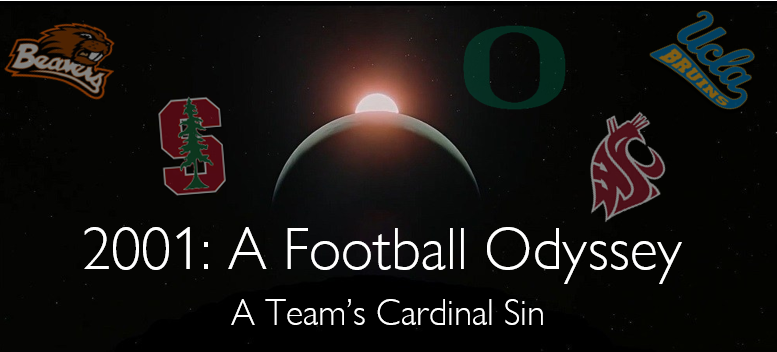
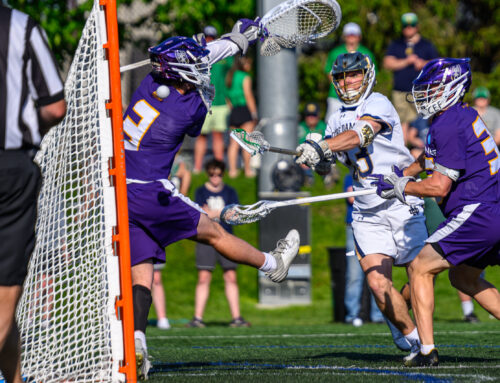
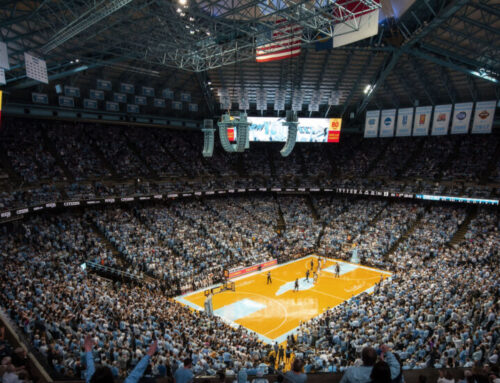
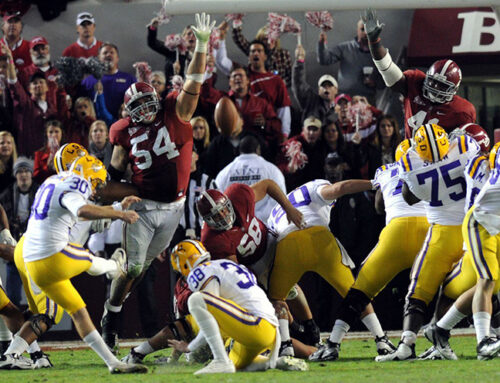
I’m blown away by how much work you put into this, nice job! I wasn’t old enough to experience this season so it’s weird to think of a time when Oregon State was considered a program on the rise, kinda like Iowa State today.
The Oregon State moment truly feels like the last CFB comet. Even the 2007 Kansas team (the closest analog imo) had a semi-successful season before falling off of the cliff again. It’s truly one of the sport’s weirdest anomalies in recent memory, if not all time.